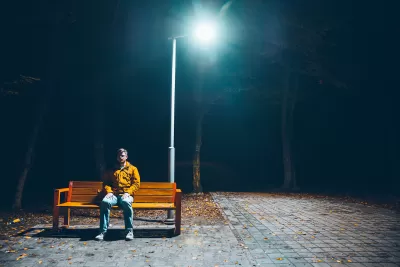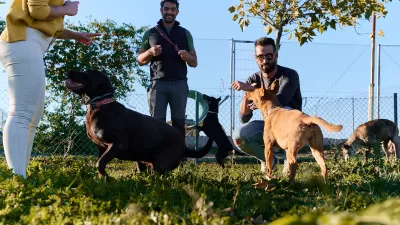Some theorists want to design cities to reduce loneliness and isolation. Others want to accommodate them.

Despite renewed attention due in part to the Surgeon General’s announcement that the nation faces a ‘loneliness epidemic,’ Alan Ehrenhalt, in a piece for Governing, notes that loneliness has been a perennial concern in American society since at least the early 20th century.
However, “Important societal changes pointing toward isolation have gathered steam in the past few decades.”
What does this have to do with urban planning? For some theorists, urban design and how we treat public space can have a significant impact on social interaction. For example, “Over the years, our parks have accumulated quite a few anti-social pieces of infrastructure: They have built unnecessary fences, placed spikes on sittable ledges and taken out benches instead of making them more inviting. Reversing those sorts of decisions would be a decent start.” Public and quasi-public ‘third spaces’ also foster social connections and offer places for people to rest and meet for free.
Others, like architecture critic Tom Brennecke, believe that cities should accommodate loneliness rather than change it. According to Brennecke, “many lonely people seem to seek social withdrawal and may, paradoxically, also benefit from being by themselves. … Public spaces should be designed to invite people to feel welcome coming alone.”
FULL STORY: The Long and Persistent History of Loneliness in America

Alabama: Trump Terminates Settlements for Black Communities Harmed By Raw Sewage
Trump deemed the landmark civil rights agreement “illegal DEI and environmental justice policy.”

Planetizen Federal Action Tracker
A weekly monitor of how Trump’s orders and actions are impacting planners and planning in America.

The 120 Year Old Tiny Home Villages That Sheltered San Francisco’s Earthquake Refugees
More than a century ago, San Francisco mobilized to house thousands of residents displaced by the 1906 earthquake. Could their strategy offer a model for the present?

Opinion: California’s SB 79 Would Improve Housing Affordability and Transit Access
A proposed bill would legalize transit-oriented development statewide.

Record Temperatures Prompt Push for Environmental Justice Bills
Nevada legislators are proposing laws that would mandate heat mitigation measures to protect residents from the impacts of extreme heat.

Downtown Pittsburgh Set to Gain 1,300 New Housing Units
Pittsburgh’s office buildings, many of which date back to the early 20th century, are prime candidates for conversion to housing.
Urban Design for Planners 1: Software Tools
This six-course series explores essential urban design concepts using open source software and equips planners with the tools they need to participate fully in the urban design process.
Planning for Universal Design
Learn the tools for implementing Universal Design in planning regulations.
Clanton & Associates, Inc.
Jessamine County Fiscal Court
Institute for Housing and Urban Development Studies (IHS)
City of Grandview
Harvard GSD Executive Education
Toledo-Lucas County Plan Commissions
Salt Lake City
NYU Wagner Graduate School of Public Service





























